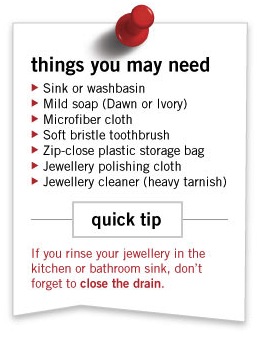Right before I started writing this article I thought “I wonder what the top advice is for cleaning sterling silver jewellery?” So I did a quick search and the results were very disappointing. Baking soda and toothpaste really? For tarnished items it doesn’t actually save you time, and when abrasives are used the metals and even stones are dulled by tiny little scratches, diminishing the luster. Using the techniques I have here are just as effective, quick, and easy.
 Maintenance and light cleaning
Maintenance and light cleaning
This cleaning method will renew the brightness to sterling that has little tarnish.
- Wash the item with a mild liquid soap and tepid water, this will remove dirt, oils, lotions, etc.
- Then wipe with a soft cloth, it shouldn’t take much to remove a light buildup of tarnish. You can also use a jewellery polishing cloth.
- For the hands free method use a sterling silver jewellery safe cleaning dip and follow the manufacturer’s directions. Only use dips designed for sterling silver jewellery, products for flatware and decor items can be damaging.
Removing heavy tarnish buildup
In most cases to renew sterling back to a bright finish you’ll need to use jewellery cleaning products, and a little elbow grease.
- Wash the item with a mild liquid soap and tepid water, use a soft cloth or soft bristle brush like an old used toothbrush.
- For the hands free method use a sterling silver jewellery safe cleaning dip and follow the manufacturer’s directions. You may need to keep the item in the dip longer than expected.
- If the item is really dark you might have to use more than one method. I recommend using wipes for stubborn tarnish.

From left to right: Dips labeled 'delicate' are ideal for cleaning sterling silver jewellery with gemstones. The Silver cleaning dip is great for all around cleaning. Give your jewellery a bright shine and buff with a polishing cloth. Last but not least these wipes excel at removing heavy tarnish. Don't forget to read the manufacturers instructions before buying and using the product.
Don’t want to DIY?
Does the above still seem like too much work? There are two things you can do.
- Bring in your jewellery to have it professionally cleaned.
- Have tarnish resistant jewellery custom made in the metal of your choice.
- Argentium Sterling Silver (tarnish resistant sterling silver alloy).
- Fine silver (soft and can be misshapen and scratched).
- White gold and platinum (platinum is extremely durable).
Contact me for more information on cleaning services and to commission custom (bespoke) jewellery.


